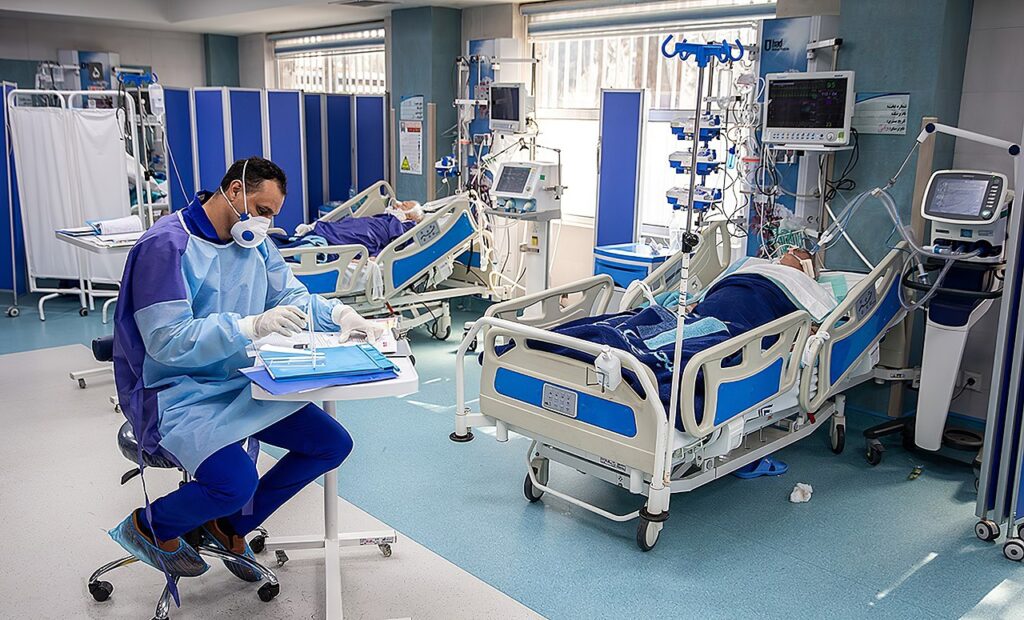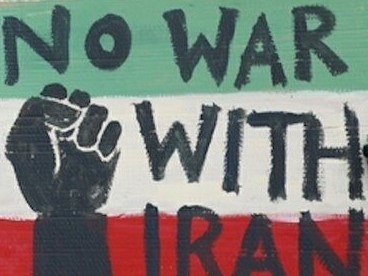The following article, by Vira Ameli, is republished from the Italian Institute for International Political Studies, where it was originally published on May 12, 2020, by permission of the author:

Coronavirus patients at the Imam Khomeini Hospital in Tehran, Iran. Photo credit: Mohsen Atayi, Farsnews.
How Sanctions Put the Health of Ordinary Iranians at Risk
by VIRA AMELI
As Iran’s coronavirus pandemic recedes and its economy slowly reopens, the prospective health security of Iranians remains under the dual threat of a looming second wave of infections and an economy in its second consecutive year of contraction under one of the harshest sanctions regimes in history. The choice between risking deaths caused directly by coronavirus or indirectly by quarantine-enforced loss of income may not be easily quantifiable through a simple cost-benefit analysis. However, the 14 per cent contraction of the Iranian economy and rapid rise in inflation caused by the re-imposition of US sanctions since November 2018 as part of Trump Administration ‘Maximum Pressure’ policy on Iran are noticeable catalytic forces behind the losses of lives and livelihoods experienced by ordinary Iranians.
When coronavirus crossed the Iranian border, the country was already fighting against an onslaught of sanctions that were blocking the import of most vital medical resources needed to contain the pandemic. As one of the first countries in a succession of Covid-19 epicentres erupting westward, its early experience was often ridiculed by international news outlets. Media narratives blaming the misery of Iranians on their government’s “botched” pandemic response, derailed critical public health debate and undermined international solidarity. Iran’s initial delay in implementing a full economic lockdown was gradually overcome through an efficient health system and civil society mobilisation, managing to keep the outbreak within healthcare capacity. At the peak of the pandemic, hospital and ICU beds met patient demand, achieving the main rationale for ‘flattening the curve’.
Notwithstanding the global chaos of Covid-19 numbers, Iran’s high recovery rates were reported even by accounts of local health centres that include all CT scanned diagnoses, not just government figures of Covid-19 testing. All this is a testament to the dedicated commitment of the healthcare cadre. Still, as doctors and nurses work night and day, sanctions risk the health security of Iranians, especially in the face of a second wave of infections, which if the history of 1918 flu repeats itself – no evidence suggesting it will not – it is bound to be more draconian. What are the mechanisms through which sanctions are risking the health security of Iranians?
Severed banking channels block most financial transactions required by Iran for its general trading, including food and medical purchases. Despite de-jure exemptions of humanitarian items, the de-facto practice prevents their trade as few foreign banks are willing to handle Iranian transactions. Recently, Iran’s Ministry of Health shared a SWIFT message showing South Korea’s Woori bank refusing to honour a 5.3 billion Won (4.1 million Dollars) letter of credit from Iran’s bank Keshavarzi, which was intended for Covid-19 testing kits. Woori bank and Industrial Bank of Korea are two banks holding Iran’s Won-denominated reserves from years of South Korean purchase of Iranian oil. But South Korea has reportedly not been able to receive the green light from Trump administration despite the supposed exemptions of humanitarian trade, and has thus refused to deliver the testing kits. This example goes further to show that, in a time of crisis, Iran is even being barred from accessing and using its own overseas assets, collected through years of legal trade, to save its people.
Inside Iran, government’s approved 2020/2021 budget, already slashed by sanctions, assumed oil revenues of about $10 billion, but with oil prices currently half of what they were in early March, $5 billion is more likely, which justifies Iran’s first request for an IMF loan in 60 years. In this economic environment, extending lockdowns simply risks too many livelihoods. On the other hand, given the history of forty years of development without foreign aid, Iran’s post-revolutionary policy of self-sufficiency has made great strides in the supply of affordable medicine and equipment. These foundations ameliorated the current crisis to an extent, by ramping production of testing kits, ventilators, and protective gear. Last week Iran exported testing kits that had received European CE marking to Germany. Still, limitations on trade disrupt supply chains of domestic production, as even locally produced medications and equipment rely on raw material from various countries. Critically, during emergencies and epidemics, health crises gain immense momentums until production is ramped up to meet increased medical demands. The Covid-19 crisis acquired massive proportions, and a recent outbreak of flu turned particularly deadly because of a financial and transport blockade that prevented timely import of Covid-19 tests and influenza vaccines.
In affirmation of these realities, customs data from Switzerland – the second largest supplier of medicine to Iran after the European Union – evidences that the export of medicine to Iran has reduced over the last year. To overcome these problems, new viable channels for trade have been sought by the European powers opposing to the US re-imposition of sanctions. The Swiss government has also tried to set up a special banking channel designed for humanitarian trade. However, both of these efforts have delivered less than promised. INSTEX, the European special-purpose vehicle, and SHTA, the Swiss Humanitarian Trade Arrangement, have each managed only a single transaction. These impediments are a manifestation of behind-the-scenes pressures threatening liability for violations of US law, implemented by Treasury Department’s Office of Foreign Assets Control (OFAC), despite Trump Administration’s referencing SHTA as evidence of efforts to protect humanitarian trade.
Fearing secondary American sanctions, European pharmaceuticals also refuse to do business with Iran, recently causing the death of 15 Iranian children suffering from a rare genetic disorder, epidermolysis bullosa (EB), after the Swedish firm Molnlycke Health Care stopped delivering Mepilex, a vital treatment for treating the chronic and acute severe skin lesions and wounds. The health security of Iranians is thus under siege while tensions between Iran and the United States continue, leaving Europeans with limited options to turn the tides.
Nevertheless, waiting is not an option when Iran’s health security is stripped-down under sanctions. It has become increasingly clear that the Trump Administration’s Maximum Pressure campaign is designed to use moments of crises to advance political gains. However, European countries have both the influence and capacity to abide by their humanitarian commitments and counter this through more proactive policy making. Recently, AstraZeneca, a British-Swedish company partnered with the University of Oxford to scale the production of the most promising vaccine currently in trial. In a globalised world, interdependence not only applies to politics and economics, but as we have recently learnt the hard way, national health securities are also epidemiologically linked; efforts to prevent power politics hindering Iranians’ chances of vaccination will pay dividends globally.
